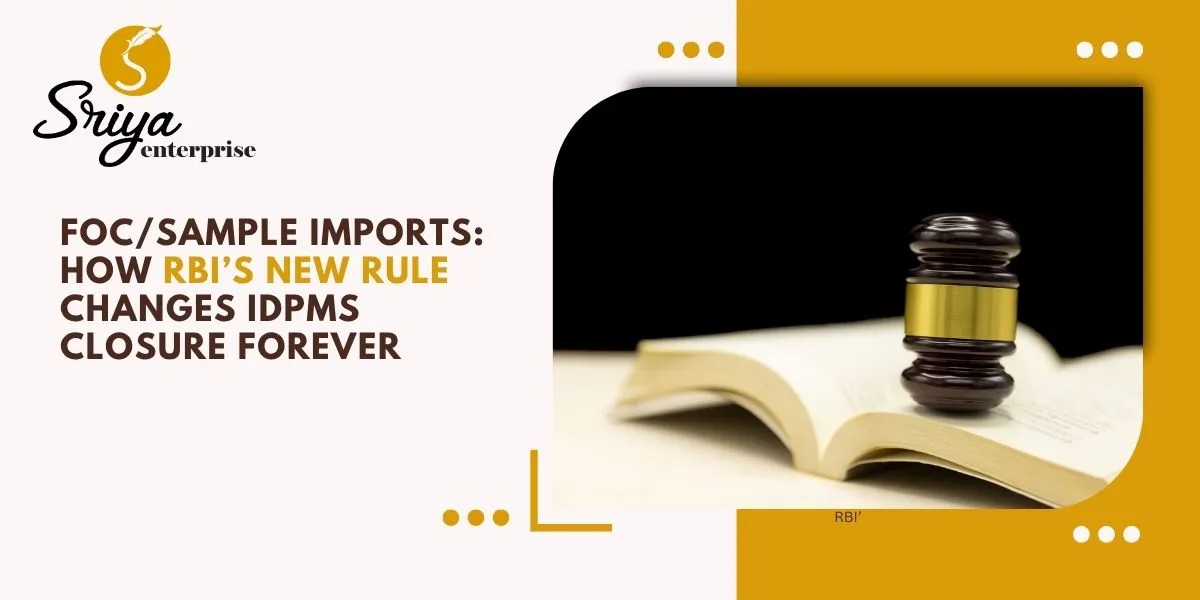RBI Update: Closing Bills of Entry for Free of Cost (FOC)/Sample Imports – Issues and…

In a proactive move to shield Indian exporters from the adverse effects of ongoing global trade disruptions and rising international tariff barriers, the Reserve Bank of India (#RBI) has introduced comprehensive #trade relief measures in 2025. These timely interventions extend key timelines for the realization and repatriation of #export proceeds, provide moratoriums and deferments on debt repayments, and enhance credit support specifically for export #finance.
Designed to boost liquidity, ease #workingcapital constraints, and safeguard business continuity in export-oriented sectors, RBI’s regulatory actions reflect a strong commitment to sustaining India’s export growth trajectory in a volatile global market. Sriya Enterprise brings you an in-depth analysis of how these RBI measures can benefit exporters and trade finance stakeholders in navigating current challenges effectively.
1. Extension of #FEMA Regulations on Export Proceeds Realization and Repatriation
The RBI has amended the Foreign Exchange Management Act (FEMA) regulations concerning the realization and repatriation of proceeds from exports of goods, software, and services:
- The permissible time period for exporters to realize and repatriate the full export value has been extended from nine months to fifteen months from the date of export from India.
- Additionally, the maximum time allowed for shipment of goods, in cases where advance payment has been received, has been increased from one year to three years from the date of receipt of advance payment or as per the agreement, whichever is later.
These extensions provide exporters with greater flexibility to manage delayed payments and shipment challenges arising from global supply chain disruptions, tariff issues, and geopolitical uncertainties and easing of regularization in #EDPMS
2. Export Packing Credit Relaxation
(i) Flexibility in Packing Credit Liquidation
Exporters who availed packing credit facilities on or before August 31, 2025, but could not dispatch goods may liquidate such facilities via legitimate alternate sources (including domestic sales proceeds of such goods) or by substituting contracts with proceeds from another export order.
These measures are designed to ease exporters’ cash flow pressures and debt servicing burdens, helping viable businesses sustain operations and manage delayed export cycles.
(ii) Relaxation in the Repayment of Export Credit
- Enhancement in maximum credit period from one year to 450 days for pre-shipment and post-shipment export credit disbursed till March 31, 2026.
- Allowing lenders to liquidate packing credit facilities availed by exporters on or before August 31, 2025, where dispatch of goods could not take place, from any legitimate alternate sources, including domestic sale proceeds of such goods or substitution of contract with proceeds of another export order.
Eligibility and Prudential Norms
To qualify for relief:
- Borrowers must be engaged in exports in specified sectors (appended below as Annexure) and have had outstanding export credit facility as of August 31, 2025.
- Borrower accounts should be classified as ‘Standard’ as on August 31, 2025.
The Reserve Bank of India’s recent regulatory steps and credit relief initiatives are timely interventions to support Indian exporters facing global trade disruptions. Extending timelines for realization and repatriation of export proceeds, coupled with moratorium on debt repayments and enhanced credit facilities, provide exporters with vital financial flexibility. These measures are expected to cushion the adverse impact of global challenges on export businesses, ensuring liquidity continuity and helping safeguard India’s trade interests in turbulent times.
Sriya Enterprise remains committed to keeping exporters and trade finance professionals informed of such important regulatory updates that shape the business environment and compliance landscape.
Annexure
| 2-Digit HS Code | Description |
| 03 | Fish and crustaceans, molluscs and other aquatic invertebrates. |
| 29 | Organic chemicals |
| 38 | Miscellaneous chemical products. |
| 39 | Plastic and articles thereof. |
| 40 | Rubber and articles thereof. |
| 42 | Articles of leather, saddlery and harness; travel goods, handbags and similar containers, articles of animal gut (other than silk-worm) gut. |
| 57 | Carpets and other textile floor coverings. |
| 61 | Articles of apparel and clothing accessories, knitted or crocheted. |
| 62 | Articles of apparel and clothing accessories, not knitted or crocheted. |
| 63 | Other made-up textile articles; sets; worn clothing and worn textile articles; rags |
| 64 | Footwear, gaiters and the like; parts of such articles. |
| 68 | Articles of stone, plaster, cement, asbestos, mica or similar materials. |
| 71 | Natural or cultured pearls, precious or semiprecious stones, precious metals, clad with precious metal and articles thereof; imitation jewellery; coin. |
| 73 | Articles of iron or steel |
| 76 | Aluminium and articles thereof. |
| 84 | Nuclear reactors, boilers, machinery and mechanical appliances; parts thereof. |
| 85 | Electrical machinery and equipment and parts thereof; sound recorders and reproducers, television image and sound recorders and reproducers, and parts. |
| 87 | Vehicles other than railway or tramway rolling stock, and parts and accessories thereof. |
| 90 | Optical, photographic cinematographic measuring, checking precision, medical or surgical inst. And apparatus parts and accessories thereof; |
| 94 | Furniture: bedding, mattresses, mattress supports, cushions and similar stuffed furnishing; lamps and lighting fittings not elsewhere specified or included |



